|
|
M82: A Starburst Galaxy
What Do These Images Tell Us?
| X-ray |
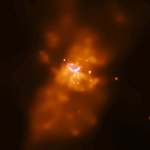 NASA/CXC/SAO NASA/CXC/SAO
/PSU/CMU |
The images show various views of M82. The Roentgen satellite (Rosat)
X-ray image shows an expanding bubble of 6 million degree Celsius
gas that extends 20,000 light years on either side of the galaxy.
The hot gas bubble, or galactic wind, was created by the very high
supernova rate of M82. The X-ray image also shows evidence for a strong
source of X-rays in the center of the galaxy. Chandra observations
should tell whether this source is due to matter falling into a supermassive
black hole. |
| Optical |
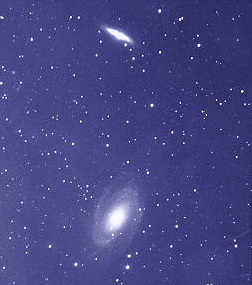 M. Weiland,
Astronomy M. Weiland,
Astronomy
Interest Group, U.Constance |
A close encounter with the large galaxy M81 (lower galaxy in optical
image at left) in the last 10 million years is thought to have triggered
the burst of star formation in M82 (upper galaxy in optical image
at left). For this reason, M82 is called a starburst galaxy. The stars
do not form all at once, but over a period of a few millions years.
The rate at which stars are forming in M82 is fifty to a hundred times
that for a normal galaxy its size. |
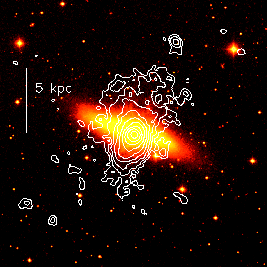 D. Strickland D. Strickland
|
Since very massive stars use up their fuel and explode in a few million
years, a star explodes about every ten years in M82. These violent
explosions heat the surrounding gas to produce the expanding hot bubble.
The hot gas blasts out of the galaxy along the path of least resistance,
perpendicular to the plane of the galaxy, as shown in the combined
optical and X-ray image. |
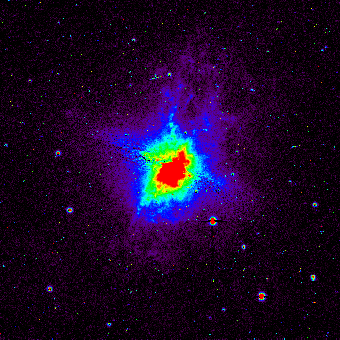 NASA,
LHEA NASA,
LHEA |
An optical image taken with a filter to isolate light emitted by hydrogen
atoms (H-alpha filter) at temperatures of about 10000 degrees Kelvin
shows a bright network of filaments. The filaments are thought to
be gas clouds that have been overtaken by the expanding hot wind and
heated by shock waves or radiation from hot young stars. |
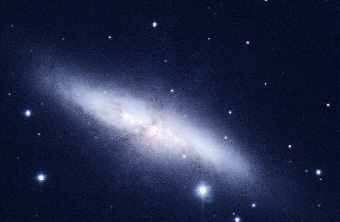 P.Challis, Whipple P.Challis, Whipple
Obs, Mt. Hopkins |
An optical image taken over a broad range of visible wavelengths shows
an irregular, blotchy galaxy. The blotchiness is due to dust, which
blocks much of the visible light from the galaxy. |
| Infrared |
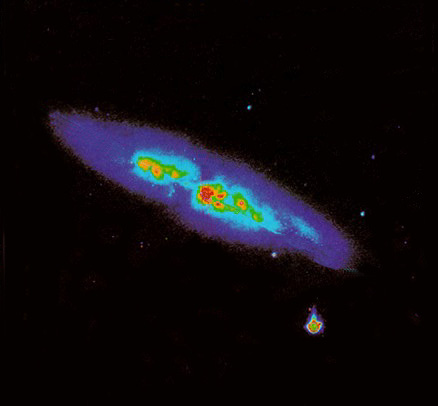
SAO |
Stars tend to form in dusty regions, so the bright spots in the infrared
image show where stars are being formed. Newly formed stars radiate
strongly and heat up the dust cloud that surrounds them producing
bright infrared sources. M82 is the brightest infrared galaxy. |
| Radio |
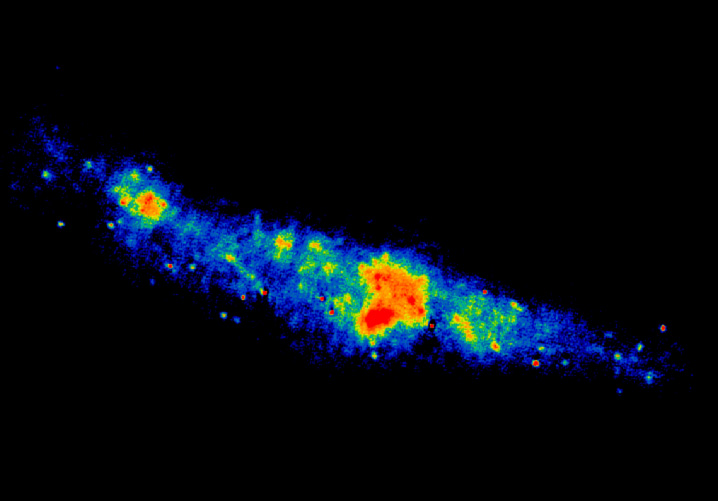 MERLIN & VLA MERLIN & VLA |
The radio image shows a region about 3000 by 2000 light year across.
It was made by combining data from the United Kingdom's MERLIN (Multi--Element
Radio--linked Radio Interferometer) with data from the Very Large
Array (VLA) in New Mexico. The small bright patches are the remnants
of supernovas that have occurred in the last thousand years, and the
large diffuse patches are thought to be caused by the accumulation
of thousands of supernovas. |
Chandra's precise X-ray images of this starburst wind,
together with optical, infrared and radio images, will enable astronomers
to study all the components of a starburst, from the formation of
stars to the explosion of matter out of the galaxy.
Return to M82 (14 Jan
00)
|
|